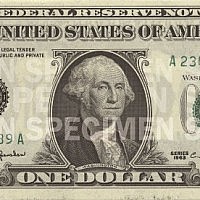Today’s currency is “denominated,” or designated, in $1, $2, $5, $10, $20, $50, and $100 notes. The $100 note is the largest currency denomination in circulation today.
Historically, U.S. currency was printed in a variety of sizes, colors, and designs. To make it easier for the public to distinguish between genuine and counterfeit currency notes, currency size was reduced, and standardized designs were instituted for each denomination in 1929.
Beginning in 1990, new series notes were issued with advanced features, such as a security thread and microprinting. In order to stay ahead of potential counterfeiting threats, the U.S. Government introduced redesigned $5, $10, $20, $50, and $100 notes, which are currently in circulation. The current $100 note design began circulation in October 2013.
Cash Facts
-
In the 1860s, an estimated 8,000 different state banks were circulating bank notes in denominations from ½ cent to $20,000. These notes came in a variety of sizes, colors, and designs, and counterfeiting was rampant. Visit the American Currency Exhibit on National Stability to learn more about the first Federal Reserve Notes issued in 1914.
-
New currency designs are developed by designers at the Bureau of Engraving and Printing (BEP), and the final design is approved by the Secretary of the Treasury. To learn about the process for designing and printing money, visit the BEP’s feature on “How Money is Made.”
-
When a redesigned note begins circulation, it is not necessary to trade in your old design notes. It is U.S. government policy that all designs of U.S. currency remain legal tender, regardless of when they were issued. This policy includes all denominations of Federal Reserve notes, from 1914 to the present.
View the gallery of U.S. currency designs below. Images courtesy of USCurrency.gov.

$1 Note
The $1 note features a portrait of George Washington on the front of the note and an image of the Great Seal of the United States on the back of the note. Of all the notes printed by the Bureau of Engraving and Printing, the $1 note makes up about 45% of currency production.

$2 Note
The $2 note features a portrait of Thomas Jefferson on the front of the note and a vignette of the Signing of the Declaration of Independence on the back of the note. There are no plans to redesign the $2 note.

$5 Note
The Series 2006 $5 note entered circulation on March 13, 2008. It features a portrait of Abraham Lincoln on the front of the note and a vignette of the Lincoln Memorial on the back of the note.

$10 Note
The Series 2004 and 2006 $10 note first entered circulation on March 2, 2006. It features a portrait of Alexander Hamilton on the front of the note and a vignette of the United States Treasury Building on the back of the note.

$20 Note
The Series 2004 and 2006 $20 note first entered circulation on October 9, 2003. It features a portrait of Andrew Jackson on the front of the note and a vignette of the White House on the back of the note.

$50 Note
The Series 2004 and 2006 $50 note first entered circulation on September 28, 2004. It features a portrait of Ulysses S. Grant on the front of the note and a vignette of the United States Capitol on the back of the note.

$100 Note
The $100 note has been the largest denomination of currency in circulation since 1969. It features a portrait of Benjamin Franklin on the front of the note and a vignette of Independence Hall on the back of the note.
The redesigned $100 note began circulating on October 8, 2013. Advanced security features in the redesigned $100 note include the 3-D Security Ribbon and the Bell in the Inkwell. These features offer a simple and subtle way to verify that a new $100 note is real.













